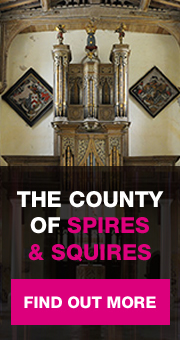The Church which lies adjacent to the House but which it antedates by some 400 years. It must have been used by the Bishops of Coventry whose seat this was before the advent of the Comptons in the 16th century. The church has become the family’s funerary chapel after they ceased to be buried at Compton Wynyates in Warwickshire in the early 19th century. The earliest architectural remains is the reset Norman door but inside it is basically late medieval, restored/improved by Lord Alwyne Compton who employed Street but who effectively controlled the work. There are two notable early 17th century features that withstood his taste. The sumptuous pulpit and the screen that was moved to the South Chapel. Anybody wishing to see what the Church looked like before the 19th century restoration only has to look at the two drawings hanging near the door. The Compton monuments commence with that to the 1st Marquis and Marchioness of Northampton. It stands at the east end of the north aisle acting as a type of reredos and allied to the stained glass window above. The whole mis-en-scene seems to have been designed by Edward Blore following Lady Northampton’s death in 1843. By then Blore had established himself as the leading Gothic/Tudorbethan early Victorian architect (later to be much abused by Pugin et al. The Ecclesiologist writing that he seemed “to be entirely unacquainted with the true spirit of Pointed Architecture” even though he was the surveyor of Westminster Abbey). His most notable London building was of course the completion of Buckingham Palace but now his East Front is now obscured by the work of Aston Webb. In the 1840s when the memorial was raised, he was also working for Charles Dickens’ friend, Robert Watson at Rockingham and for Lord Clifden at Holdenby. Close by is a memorial to the wife of the 2nd Marquis who had died in 1830. Margaret Douglas-Maclean-Clephane is immortalised rising in a shell in the upper section. Below a relief showing Charity with an affecting inscription “Adieu, dear shade for ever, oh not so Affection, Faith and Hope all echo know Although thy vertue slumber in the tombe Thy beauty fade amidst Sepulchral Gloom Although the grave they love remains obscure And death dark chilly stream our hearts divide Yet trust I will to meet on that blessed shore Where joy abides and parting is no more.” The sculptured elements of the tomb were made in Rome by Pietro Tenerani (1789-1870) who was the principle Italian sculptor following the death of Canova. His works include the colossal monument to Pope Pius XIII in St. Peter’s. The Northamptons would have known his work well as they largely resided in Italy from 1820-1830. Again near by, against the wall, is another monument by an Italian. This is to Lady Margaret Compton, wife of the Hon. Edward Leveson Gower by Baron Carlo Marochetti (1805-1867). He was born in Turin but due to Napoleonic upheavals spent his youth in Paris. It was in these two cities that he made his considerable reputation and the only reason he emerges in England in 1848 and stays here to become one of Queen Victoria’s favourite artists, was the outbreak of revolution in France. He may have been chosen by the Northamptons on account of the bust he made of Lady Constance Gower (later Duchess of Westminster) which he exhibited at the Royal Academy in 1851. He is probably best known for the great equestrian monument of Richard, Coeur de Lion, which stands outside the Palace of Westminster. In this monument Lady Margaret, daughter of the 2nd Marquis, is represented as a young girl with plaited hair and roses, somewhat odd perhaps for a woman who was nearly 40. Above an angel in relief is gently lifting her drapery. All is set in a spectacular niche of red striated marble with green columns which were supplied by Messrs. Gillet of Leicester (Marochetti was a strong advocate of polychromy). We at last come to the largest monument in the Church which you can’t fail to have noticed at the west end. Again by Tenerani this is to Spencer, 2nd Marquis, who outlived his wife by some 20 years. It was sculpted in Rome and shipped to England in 1856. The over life size Angel of the Resurrection, carrying his trump (for the last) and his book of the saved, dominates the inscribed plinth. If you fail to get the message, here you will find it. “The trumpet shall sound and The dead shall be raised Incorruptible and we shall be changed – Handel in white marble The scale is possible appropriate for his lordship was one of the few people to have had a dinosaur named after him. Regnosaurus Northamptoni. You may also notice two earlier memorials, pre Compton. An effigy in Purbeck marble of a Knight thought to be Sir David de Esseby, early 13th century and a very elaborate brass to the Rector, William Ermyn, who died in 1401. It’s particularly important as it shows an elaborate alb with saints under niches – a rare sighting of opus anglicorum. Before leaving the church, take a look at the Chancel as in its way this is a memorial to the Rt. Rev. Lord Alwyne Compton (1825-1906), younger son of the 2nd Marquis, Rector here for over 25 years and subsequently Dean of Worcester and Bishop of Ely. He took a deep interest in church refurbishments along Tractarian lines and the Chancel reflects his taste. Note the inscription “Lord I have loved the habitations of they house and the place where they honour dwelleth”. We have arrived at the Victorian notion of the beauty of holiness expressed in wall decorations, stained glass and tiles. The latter were designed for the Revd. Lord Alwyne for the Minton factory. Note the ones that replace earlier floor monuments in the aisle. Near the South Porch you will see a bronze of St Mary Magdalene recently installed which is by the Easton Maudit artist, Clare Abbatt. In the graveyard you will find Boehm’s tomb to Eliza Elliot, wife of the 4th Marquis who died in 1877 – another large white angel and to her son William, 5th Marquis, d. 1913, where four angels pray over his grave.
Please refer to the Glossary for any terms in the text that you are unfamiliar with.







